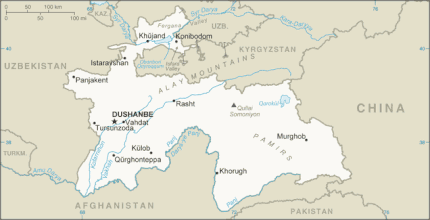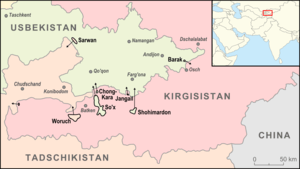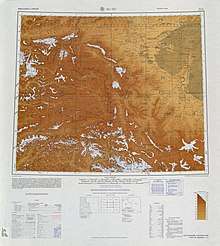Kyrgyzstan–Tajikistan border
The Kyrgyzstan–Tajikistan border is 984km (611m) and runs from the tripoint with Uzbekistan to the tripoint with China.[1]

Description
The border starts in the north at the tripoint with Uzbekistan in the Ferghana Valley. The border proceeds roughly westwards, with a sharp Tajik protrusion at the town of Chorku; it almost reaches the Kayrakkum Reservoir, however a thin strip of Tajik territory lies between the reservoir and the border. It then turn southwards near the Tajik enclave of Kayragach before turning sharply eastwards upon reaching the Turkestan Range. The border then follows this range, and the Alay and Trans-Alay ranges, eastwards to the Chinese tripoint.
Enclaves

There are two enclaves along the border (Vorukh and Kayragach), both Tajik enclaves within Kyrgyzstan.
History
Russia had conquered Central Asia in the 19th century by annexing the formerly independent Khanates of Kokand and Khiva and the Emirate of Bukhara. After the Communists took power in 1917 and created the Soviet Union it was decided to divide Central Asia into ethnically-based republics in a process known as National Territorial Delimitation (or NTD). This was in line with Communist theory that nationalism was a necessary step on the path towards an eventually communist society, and Joseph Stalin’s definition of a nation as being “a historically constituted, stable community of people, formed on the basis of a common language, territory, economic life, and psychological make-up manifested in a common culture”.
The NTD is commonly portrayed as being nothing more than a cynical exercise in divide and rule, a deliberately Machiavellian attempt by Stalin to maintain Soviet hegemony over the region by artificially dividing its inhabitants into separate nations and with borders deliberately drawn so as to leave minorities within each state.[2] Though indeed the Soviets were concerned at the possible threat of pan-Turkic nationalism[3], as expressed for example with the Basmachi movement of the 1920s, closer analysis informed by the primary sources paints a much more nuanced picture than is commonly presented.[4][5][6]
The Soviets aimed to create ethnically homogeneous republics, however many areas were ethnically-mixed (e.g. the Ferghana Valley) and it often proved difficult to assign a ‘correct’ ethnic label to some peoples (e.g. the mixed Tajik-Uzbek Sart, or the various Turkmen/Uzbek tribes along the Amu Darya).[7][8] Local national elites strongly argued (and in many cases overstated) their case and the Soviets were often forced to adjudicate between them, further hindered by a lack of expert knowledge and the paucity of accurate or up-to-date ethnographic data on the region.[9][10] Furthermore NTD also aimed to create ‘viable’ entities, with economic, geographical, agricultural and infrastructural matters also to be taken into account and frequently trumping those of ethnicity.[11][12] The attempt to balance these contradictory aims within an overall nationalist framework proved exceedingly difficult and often impossible, resulting in the drawing of often tortuously convoluted borders, multiple enclaves and the unavoidable creation of large minorities who ended up living in the ‘wrong’ republic. Additionally the Soviets never intended for these borders to become international frontiers as they are today.

NTD of the area along ethnic lines had been proposed as early as 1920.[13][14] At this time Central Asia consisted of two Autonomous Soviet Socialist Republics (ASSRs) within the Russian SFSR: the Turkestan ASSR, created in April 1918 and covering large parts of what are now southern Kazakhstan, Uzbekistan and Tajikistan, as well as Turkmenistan), and the Kirghiz Autonomous Soviet Socialist Republic (Kirghiz ASSR, Kirgizistan ASSR on the map), which was created on 26 August 1920 in the territory roughly coinciding with the northern part of today's Kazakhstan (at this time Kazakhs were referred to as ‘Kyrgyz’ and what are now the Kyrgyz were deemed a sub-group of the Kazakhs and referred to as ‘Kara-Kyrgyz’ i.e. mountain-dwelling ‘black-Kyrgyz’). There were also the two separate successor ‘republics’ of the Emirate of Bukhara and the Khanate of Khiva, which were transformed into the Bukhara and Khorezm People's Soviet Republics following the takeover by the Red Army in 1920.[15]
On 25 February 1924 the Politburo and Central Committee of the Soviet Union announced that it would proceed with NTD in Central Asia.[16][17] The process was to be overseen by a Special Committee of the Central Asian Bureau, with three sub-committees for each of what were deemed to be the main nationalities of the region (Kazakhs, Turkmen and Uzbeks), with work then exceedingly rapidly.[18][19][20][21][22] There were initial plans to possibly keep the Khorezm and Bukhara PSRs, however it was eventually decided to partition them in April 1924, over the often vocal opposition of their Communist Parties (the Khorezm Communists in particular were reluctant to destroy their PSR and had to be strong-armed into voting for their own dissolution in July of that year).[23]
Originally the border was much longer, as the Uzbek SSR included the Khojand region as well as the rest of what is now Tajikistan as the Tajik ASSR. The border assumed its current position in 1929, with Tajikistan gaining Khojand and becoming a full SSR.[24][25] The Kara-Kirghiz Autonomous Oblast was originally within the Russia SSR in October 1924, with borders matching those of modern Kyrgyzstan. In 1925 it was renamed the Kirghiz Autonomous Oblast in May 1925, then became the Kirghiz ASSR in 1926 (not to be confused with the Kirghiz ASSR that was the first name of Kazak ASSR), and finally it became the Kirghiz SSR in 1936.[26]
The boundary became an international frontier in 1991 following the dissolution of the Soviet Union and the independence of its constituent republics. There were tensions in the post-independence era over border delimitation and policing, and especially after an Islamic Movement of Uzbekistan (IMU) incursion into Kyrgyzstan from Tajik territory in 1999/2000.[27][28] At present border delimitation is ongoing.[29][30]
Border crossings
Settlements near the border
Kyrgyzstan
History maps
Historical English-language maps of the Kyrgyz SSR-Tajik SSR border, mid to late 20th century:
References
- CIA World Factbook - Kyrgyzstan, 23 September 2018
- The charge is so common as to have become almost the conventional wisdom within mainstream journalistic coverage of Central Asia, with Stalin himself often the one drawing the borders, see for example Stourton, E. in The Guardian, 2010 Kyrgyzstan: Stalin's deadly legacy https://www.theguardian.com/commentisfree/2010/jun/20/kyrgyzstan-stalins-deadly-legacy; Zeihan, P. for Stratfor, 2010 The Kyrgyzstan Crisis and the Russian Dilemma https://worldview.stratfor.com/article/kyrgyzstan-crisis-and-russian-dilemma; The Economist, 2010 Kyrgyzstan - Stalin's Harvest https://www.economist.com/briefing/2010/06/17/stalins-harvest?story_id=16377083; Pillalamarri, A in the Diplomat, 2016, The Tajik Tragedy of Uzbekistan https://thediplomat.com/2016/09/the-tajik-tragedy-of-uzbekistan/; Rashid, A in the New York Review of Books, 2010, Tajikistan - the Next Jihadi Stronghold? https://www.nybooks.com/daily/2010/11/29/tajikistan-next-jihadi-stronghold; Schreck, C. in The National, 2010, Stalin at core of Kyrgyzstan carnage, https://www.thenational.ae/world/asia/stalin-at-core-of-kyrgyzstan-carnage-1.548241
- Bergne, Paul (2007) The Birth of Tajikistan: National Identity and the Origins of the Republic, IB Taurus & Co Ltd, pg. 39-40
- Haugen, Arne (2003) The Establishment of National Republics in Central Asia, Palgrave Macmillan, pgs. 24-5, 182-3
- Khalid, Adeeb (2015) Making Uzbekistan: Nation, Empire, and Revolution in the Early USSR, Cornell University Press, pg. 13
- Edgar, Adrienne Lynn (2004) Tribal Nation: The Making Of Soviet Turkmenistan, Princeton University Press, pg. 46
- Bergne, Paul (2007) The Birth of Tajikistan: National Identity and the Origins of the Republic, IB Taurus & Co Ltd, pg. 44-5
- Edgar, Adrienne Lynn (2004) Tribal Nation: The Making Of Soviet Turkmenistan, Princeton University Press, pg. 47
- Bergne, Paul (2007) The Birth of Tajikistan: National Identity and the Origins of the Republic, IB Taurus & Co Ltd, pg. 44-5
- Edgar, Adrienne Lynn (2004) Tribal Nation: The Making Of Soviet Turkmenistan, Princeton University Press, pg. 53
- Bergne, Paul (2007) The Birth of Tajikistan: National Identity and the Origins of the Republic, IB Taurus & Co Ltd, pg. 43-4
- Starr, S. Frederick (ed.) (2011) Ferghana Valley – the Heart of Central Asia Routledge, pg. 112
- Bergne, Paul (2007) The Birth of Tajikistan: National Identity and the Origins of the Republic, IB Taurus & Co Ltd, pg. 40-1
- Starr, S. Frederick (ed.) (2011) Ferghana Valley – the Heart of Central Asia Routledge, pg. 105
- Bergne, Paul (2007) The Birth of Tajikistan: National Identity and the Origins of the Republic, IB Taurus & Co Ltd, pg. 39
- Edgar, Adrienne Lynn (2004) Tribal Nation: The Making Of Soviet Turkmenistan, Princeton University Press, pg. 55
- Bergne, Paul (2007) The Birth of Tajikistan: National Identity and the Origins of the Republic, IB Taurus & Co Ltd, pg. 42
- Edgar, Adrienne Lynn (2004) Tribal Nation: The Making Of Soviet Turkmenistan, Princeton University Press, pg. 54
- Edgar, Adrienne Lynn (2004) Tribal Nation: The Making Of Soviet Turkmenistan, Princeton University Press, pgs. 52-3
- Bergne, Paul (2007) The Birth of Tajikistan: National Identity and the Origins of the Republic, IB Taurus & Co Ltd, pg. 92
- Starr, S. Frederick (ed.) (2011) Ferghana Valley – the Heart of Central Asia Routledge, pg. 106
- Khalid, Adeeb (2015) Making Uzbekistan: Nation, Empire, and Revolution in the Early USSR, Cornell University Press, pg. 271-2
- Edgar, Adrienne Lynn (2004) Tribal Nation: The Making Of Soviet Turkmenistan, Princeton University Press, pgs. 56-8
- Bergne, Paul (2007) The Birth of Tajikistan: National Identity and the Origins of the Republic, IB Taurus & Co Ltd, pg. 55
- Rahim Masov, The History of the Clumsy Delimitation, Irfon Publ. House, Dushanbe, 1991 (in Russian). English translation: The History of a National Catastrophe Archived 2016-12-10 at the Wayback Machine, transl. Iraj Bashiri, 1996
- Haugen, Arne (2003) The Establishment of National Republics in Central Asia, Palgrave Macmillan, pg. 167
- Trofimov, Dmitriy (2002), Ethnic/Territorial and Border Problems in Central Asia, retrieved 28 October 2018
- International Crisis Group (4 April 2002), CENTRAL ASIA - BORDER DISPUTES AND CONFLICT POTENTIAL (PDF), retrieved 28 October 2018
- Asia-Plus (3 March 2018), Tajikistan, Kyrgyzstan expected to resume border talks in the second half of March, archived from the original on 4 November 2018, retrieved 4 November 2018
- EurAsia Daily (1 February 2018), Kyrgyz president paying "courtesy visit" to Tajikistan. Is that all?, retrieved 4 November 2018
- Caravanistan - Kyrgyzstan border crossings, retrieved 23 September 2018
| Wikimedia Commons has media related to Kyrgyzstan-Tajikistan border. |


